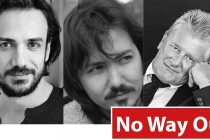The world premiere of the documentary ‘A Thousand Words; The Voice Behind the Image’ about Nevcihan Oluşum and her iconic photo took place online on Sunday, 20 December.
The screening of the film by the British Turkish Cypriot Association (BTCA) occurred on the 57th anniversary of ‘Bloody Christmas’ – the start of the decade-long assault and oppression of Cyprus’ Turkish community.
Then a young mother, Mrs Oluşum’s grief-stricken face was captured by British war photographer Sir Don McCullin on 20 March 1964, moments after she learned that her husband had been killed by Greek Cypriots as he tried to defend their home in Gaziveren, a coastal village in northwest Cyprus. Her distraught 9-year-old son Kubilay is shown extending his hand to his mother to help console her.
McCullin’s photograph, published by The Observer, went on to win World Press Photo of the Year in 1964.
The image has been reproduced thousands of times since, but few knew the tragic story about the woman whose face has become synonymous with the plight and suffering of Turkish Cypriots between December 1963 and the summer of 1974.
The new 24-minute long film about Nevcihan Oluşum is based on the 2015 documentary ‘Bir Fotoğrafın Hüznü’ [The Sadness of a Photograph], by Turkish Cypriot state broadcaster Bayrak Radyo Televizyon Kurumu (BRT).
BTCA’s film project came about this summer after one of its activists, Sonya Karafistan, was scrolling through posts on social media about 20thJuly – Peace and Freedom Day for Turkish Cypriots.
Nevcihan Oluşum on Greek Cypriots’ misuse of the photo for their propaganda: “I have felt every one of those claims. Like a dagger”
“I came across a post that had been shared by people citing yet another misappropriation of this [Nevcihan Oluşum] image,” Ms Karafistan told T-VINE.
NEPOMAK, a UK-based Greek Cypriot youth organisation, and many Greek Cypriots including model Sophia Hadjipanteli had shared posts of this iconic photo with the deeply offensive and false claim that Mrs Oluşum was a Greek Cypriot who had suffered at the hands of the Turkish army in 1974.
Sonya Karafistan, who is also on the management committee of the Council of Turkish Cypriot Associations UK (CTCA) – the national umbrella body for British Turkish – quickly got involved in the campaign to help remove the offending Greek Cypriot propaganda posts.
She tried to gather information about Mrs Oluşum, who died in 2018, for the national British press who were interested in running a story on the misuse of this award-winning photo.
“I went online to see if I could find some information in English on the woman behind this famous image. There were lots written about Sir Don McCullin and his time in Cyprus, lots of interviews with him, but nothing about the woman herself,” Sonya explained.
The North London activist whose family is originally from Yeşilırmak, another coastal village near to Gaziveran, spoke to Mrs Oluşum’s family. The exchange gave Sonya the idea of producing an English language documentary.
BTCA documentary A Thousand Words; The Voice Behind the Image about Nevcihan Oluşum
“I had made contact with both the daughter and daughter-in-law of Nevcihan Oluşum. They told me how devastated the family were and how helpless they felt in trying to prevent the misuse of the image.
“Both women told me it had caused Mrs Oluşum enormous pain in her lifetime, and her son Kubilay – the young boy in the photo – was also deeply disturbed by how Greek Cypriots used the photo as propaganda despite the family’s protests. I felt it was our duty as a community to stop this happening again.
“Telling the world Nevcihan Oluşum’s story in her own words in English would be a start. And when her daughter-in-law Mehtap shared the link to this BRT documentary, the first thing I replied was this story must be told in English,” said Sonya.
Her BTCA colleagues agreed on the importance of re-telling Nevcihan Oluşum’s story in English and Sonya duly contacted BRT for permission to use their footage for the new documentary.
“I have seen this picture hundreds of times and now I know the story behind those sad eyes. The world needs to know and understand the truth of what really happened”
Sonya also received support from Dr. Muharrem Özdemir, an Assistant Professor at Girne American University. Dr Muharrem was behind the research that underpinned the BRT documentary, and who offered BTCA “invaluable” guidance for their film.

Sonya took on the task of transcribing the original documentary from Turkish into English – no mean feat given that much of the Turkish commentary is colloquial:
“There was lots of emotional inflection which meant I had to listen again and again to make sure I understood exactly what was being said.”
CTCA chair Ertogrul Mehmet and BTCA head Ersu Ekrem checked the translation, before the English transcript was passed to Julia Hermann-Malabre, who did the voiceover.
“Since we were bringing the film to an audience who we assume would know very little about the Cyprus Conflict, we included some historical context and other vital facts,” said Sonya.
The team of volunteers also included singer-songwriter and producer Japha Huse, who used his editing skills to pull together the film’s sound and visuals.
The documentary, undertaken on a shoestring budget, took four months to complete. Through eyewitness testimony, it offers a powerful rebuttal of claims that the Cyprus Conflict started with Turkey’s intervention in July 1974.
First and foremost though, it tells the personal tragedy of Nevcihan Oluşum, who was pregnant with her third child when her husband Hüseyin Niyazi Hasan died.
The clip has been watched nearly 1,000 times since first airing on BTCA’s YouTube channel 24 hours ago.
A comment from one viewer, Teresa Cafer, said: “Oh my goodness what a sad film, but a very brave and proud Turkish woman. I have seen this picture hundreds of times and now I know the story behind those sad eyes. The world needs to know and understand the truth of what really happened.”
“I hope that out of respect for the memory of Nevcihan Oluşum, Sir Don supports efforts to stop this image from being misappropriated”
Sonya hopes Sir Don McCullin will also watch the short film and exercise his rights as the copyright holder of the iconic photograph to prevent it from being misused in future:
“Mrs Oluşum clearly states when interviewed in 2015 how distressing it has been to see Greek Cypriots misuse Sir Don’s photo for their twisted propaganda. She says ‘I have felt every one of those claims. Like a dagger.’

“I hope that out of respect for the memory of Nevcihan Oluşum and her family, Sir Don supports their efforts to stop this image from being misappropriated again,” stated Sonya.
BTCA intends for this film project to be the first of many, helping anyone interested in the Cyprus Conflict to gain a better understanding of the actual history of the conflict and the losses endured by Turkish Cypriots, which are regularly overlooked by international media:
“If funding becomes available, our ambition is to adapt three or four films a year to share with the wider world,” a group spokesperson said.
As Sonya noted, “Our community is very good at talking amongst ourselves,” but “telling the story in English is by far much more important than repeating it to an audience who are already familiar with the events and story of a Nevcihan Oluşum.”
Main image top of Don McCullin receiving the World Press Photo Award on 17 Dec. 1964 in front of the photo he’d taken of Nevcihan Oluşum in Cyprus earlier that year. Photo © Nijs, Jac. de / Anefo, Wikipedia / CC0




